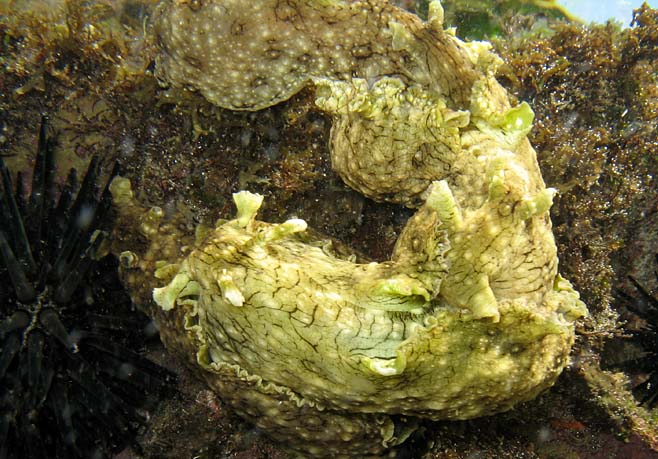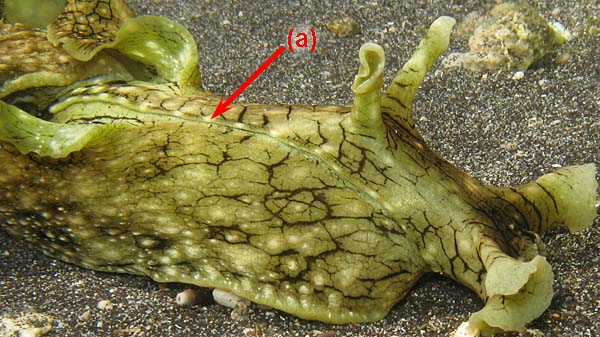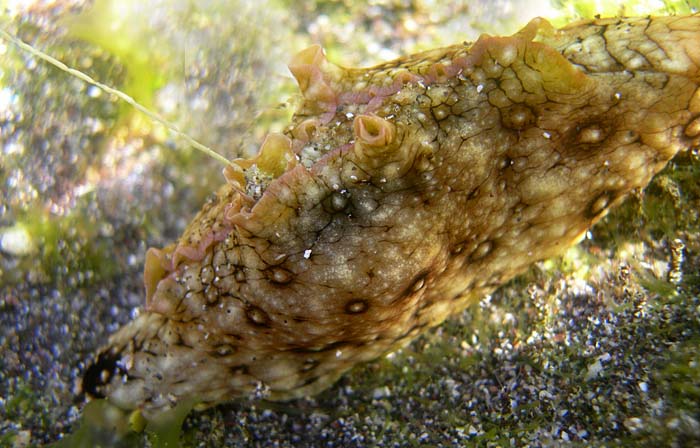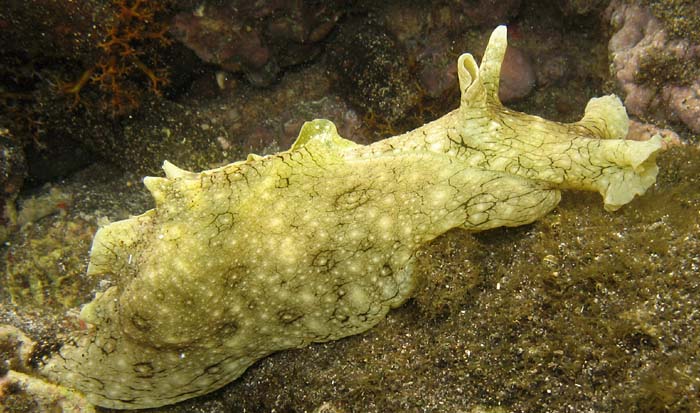This species has been observed on Reunion, Mauritius, Rodrigues, Mayotte and Madagascar Islands
Species characteristics : The body is pale brown to olive green with reticulate black markings that join to form circles, especially on the parapodia. It has high and thick parapodia, which join low down posteriorly near the tail. The body of this species is thicker and firmer, almost leathery, than most species of Aplysia. |

|
|
| Showing species characteristics... | Photo Alain Barrére |
|
See more about : Aplysia argus variability in Southwest Indian ocean
See more about : Sightening and mating periods
| Remarks :
|
 |
Bibliographic data :
Variation in coloration and thickness of its black lines and rings can be seen. In south of Indian ocean it seems that the rings can become quite small.
This species is also characterized by its large white spots and greeny black colour on the inside of the parapodia (see below Philibert Bidgrain specimen).
Like many sea hares, it's largely nocturnal. Animals are often seen actively crawling in tide pools at night but during the day the animals usually remain inactive in crevices and under rocks.
This sea hares often forming mating chains of 3 or more animals where the ones in the middle are acting as males and females simultaneously
The eggs of Aplysia argus are frequently seen intertidal and down to approximately three meters; they appear as a long tangled string of variably shaded green, brown or purple and look suspiciously similar spaghetti.
A. argus seems to be a fairly specialized red algal feeder , Rogers et al (2000) finding it would only eat Laurencia obtusa. It seems that A. argus as many sea hares can change their diet but seem to settle on red algae. When they move inshore they can live on green algae, such as Ulva and Enteromorpha.
One side effect of eating only green algae would be that the sea hare would lose its ability to produce its "red ink = purple fluid ", the pigment of which is derived from red algae.
When disrupted it will discharge a "purple fluid".
Material examined by Nathalie Yonow ( see reference/publications).
Tree specimens collected from Grand Baie (Mauritius), 14 and 24 October 1985, size : 100, 130 and 180 mm. And one from Pereybere (Mauritius) 27 October 1985, size : 200 mm
References :
Bill Rudman Seaslug site : Sea Slug Forum : Aplysia dactylomela
Sea Slug of Hawai'i : Aplysia argus
Publications :
Alexander J. and Valdés A. (2013) The Ring Doesn’t Mean a Thing: Molecular Data Suggest a New Taxonomy for Two Pacific Species of Sea Hares (Mollusca: Opisthobranchia, Aplysiidae). Pacific Science vol 67 p 287-294
Martínez E. & Ortea J. (1990). Moluscos opistobranquios de Cabo Verde: Anaspidea (Aplysiomorpha). Publicações Ocasionais da Sociedade Portuguesa de Malacologia. 15: 17-42.
Rang, S. (1828). Histoire naturelle des Aplysiens, première famille de l'ordre des Tectibranches. 84 pp., Plates 1-24. In: Férussac, D., Histoire naturelle générale et particulière des Mollusques . Firmin Didot: Paris .
Rogers, C.N., De Nys, R., Charlton, T.S. & Steinberg, P.D. (2000) Dynamics of algal secondary metabolites in two species of Sea Hare. J. Chem. Ecol., 26(3) : 721-744.
Sneha Chandran, B.K, Valdés, A., Ravinesh, R. and A. Biju Kumar.(2016) Confirmed report of Aplysia argus Rüppell & Leukart, 1830 (Mollusca: Opistobranchia: Aplysiidae) from lakshadweep, with notes on its taxonomy in India. Journal of Aquatic Biology & Fisheries Vol 4, p 147-151
Yonow, N. and Hayward , P. J. (1991). Opistobranches de l'île Maurice, avec la description de deux espèces nouvelles (Mollusca : Opistobranchia) Revue française d'aquariologie herpétologie, 18 (1), 1-30
Other photos of Aplysia argus :
 |
Philibert Bidgrain Reunion, Souris blanche lagoon, Trois Bassins, on a beach rock, less 1 m, 8 December 2006. This sea hares often forming mating chains of 3 or more animals where the ones in the middle are acting as males and females simultaneously |
 |
Souris blanche lagoon, Trois Bassins, on a beach rock, less 1 m, 8 December 2006, size : 70 mm (a) External autospermal groove (b) Spawn, 8 January 2007
|
Eva Fontaine Reunion, Souris blanche, Trois Bassins, on the rocky coast, less 1 m , 10 May 2009, size : 200 mm Rhinophores and the oral tentacles detail. The common name "sea hare" came from the rabbit-like appearance of this sea slug, the rhinophores suggesting long rabbit ears. (a) Oral (cephalic) tentacle (b) Rhinophore (c) Eye
|
 |
 |
Philibert Bidgrain Reunion, "La souris blanche" at Trois Bassins, along a beach rock, 07 November 2006 actively crawling on the morning, size : 120 mm This species is characterized by its large white spots and greeny black colour on the inside of the parapodia The body is pale brown to olive green with reticulate black markings that join to form circles, especially on the parapodia. |
In "La souris blanche", along a beach rock, there is an important population of A. argus. All the specimens eat voraciously Enteromorpha. In this spot, this species cohabit with A.oculifera.
|
 |
Reunion, Animal size : 255 mm, shell size : 26 mm. You can observed the large white spots and greeny black colour on the inside of the parapodia The parapodia join low down posteriorly near the tail.
|
Maurice Jay.  |
Alain Barrère Reunion, "La souris blanche" at Trois Bassins, along a beach rock, 04 November 2006, size : 40 mm Excretory time.... |
 |
 |
Philibert Bidgrain Reunion, "La souris blanche" at Trois Bassins, along a beach rock, 08 December 2006, size : 50-60 mm A pale green specimen.... |
Philippe Bourjon Reunion, l'Ermitage lagoon, less 1 m, 16 April 2016
The sole of the foot.... |
 |
 |
Alexandre Laporte Madagascar, Sainte Marie, Antafondro Lodge, less 1 m, 2 September 2017, size : 150 mm
|
More photos from Indian Ocean
See more about : Aplysia argus variability in Southwest Indian ocean
Mauritius, Aplysia argus, at Mahebourg, by David Caron
Mauritius, trailing behavior in Aplysia argus, at Mahebourg, by David Caron
Reunion, Aplyia argus, at Saint Leu, by Sonia Ribes Beaudemoulin
Mayotte, Aplysia argus, at Moutsoumbatsou, by Matthias Deuss

